
A computational laboratory provides modern computational and research facilities for computer science professionals, aiming to offer the necessary computational and simulation resources to meet the needs of experts and scientists in computer sciences.
Computer scientists must collaborate with cognitive scientists, economists, managers, social scientists, legal experts, humanities researchers, and philosophers on how to create IT infrastructures and technological innovations that are sustainable, ethical, and reliable.
The computational laboratory focuses on various aspects of high-performance computing (HPC) and its application in diverse sciences. Designing and testing efficient computational algorithms and adaptive scheduling policies for scientific computing on GPUs, cloud computing, and interdisciplinary research are at the core of this lab’s activities and philosophy.
Setting up such laboratories requires significant investment. As a result, many companies opt for renting computational laboratories instead. Amirkabir Simulators is one such company offering extensive assistance with renting these types of labs.
Some typical activities conducted in computational labs include:
In a computational lab, computing is utilized as a process involving computer technology to accomplish a specific and purposeful task. Computing may involve designing and developing software and hardware systems for a wide range of purposes, often including diverse structures, information processing, and management to aid scientific studies, build intelligent systems, and develop media for entertainment and communication.
A computer system uses multiple devices arranged in various configurations to solve numerous problems. In a computational environment, several computers collaborate to process and exchange information while addressing multiple issues. Below are different types of computing environments:
In a personal computational lab, a single computer system exists, where all system processes are executed on the available computer. Devices constituting a personal computing environment include laptops, mobile phones, printers, scanners, and more.
This environment allows multiple users to share the system simultaneously. Each user is allocated a time slice, and the processor rapidly switches between users. Thus, each user perceives exclusive usage of the system.
In this setup, a client requests resources, and the server provides them. While a single server may serve multiple clients simultaneously, communication between them is usually via a computer network, though they may exist on a single system.
A distributed computing environment comprises multiple nodes that are physically separate but connected via a network. All nodes communicate with one another and perform processes simultaneously. Each node contains a small portion of the distributed operating system.
In cloud-based computational labs, computing shifts from individual systems to supercomputers within a cloud computing environment. Cloud users see only the services provided without knowing the underlying details. Resources are pooled and managed through specific software.

Cluster computing resembles parallel computing, as both have multiple processors. However, cluster systems consist of two or more separate computers integrated into a parallel system.
Parallel computing involves dividing a task into smaller segments and executing them simultaneously, each on its processor or computer. Examples include weather forecasting, movie special effects, and desktop software applications.
Quantum computing leverages quantum mechanics to process information, revolutionizing fields like communication and artificial intelligence. Companies like IBM, Microsoft, and Google are actively developing reliable quantum computers.
A computational laboratory utilizes computer technologies to design and develop software and hardware systems. Computational technologies assist in scientific research, building intelligent systems, and creating various media for communication and entertainment.
Since setting up such a lab is costly and complex, many organizations prefer renting. Amirkabir Simulators is one of the leading companies providing such rental services.
What is soft computing?
Soft computing is a computational model designed to solve nonlinear problems and assist in tasks requiring human intelligence. Probabilistic models, fuzzy logic, neural networks, and evolutionary algorithms are part of soft computing.
Why cloud computing?
Cloud computing accelerates the deployment of applications, prevents data loss through robust backup systems, and reduces organizational costs by utilizing remote resources instead of servers and other equipment.
How is quantum computing changing the world?
Quantum computing has the potential to revolutionize communication and artificial intelligence. Companies like IBM, Microsoft, and Google are at the forefront of building reliable quantum computers.
What is the future of computing?
Today’s computers operate using semiconductors, metals, and electricity. Future computers may use atoms, DNA, or light. As computing transitions from quartz to quantum, processing speeds could exceed current scales.
Sources